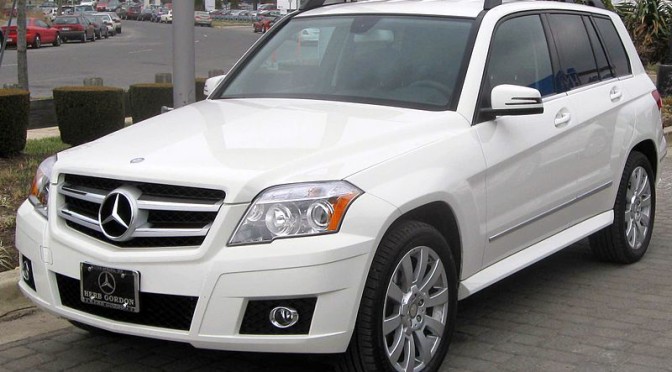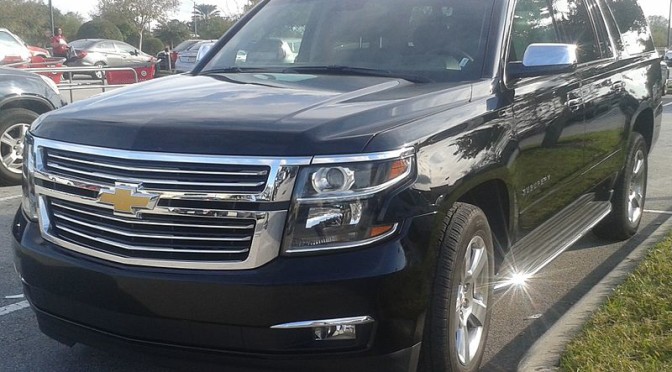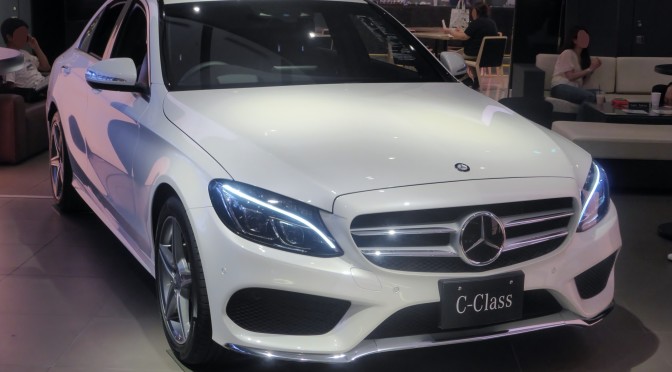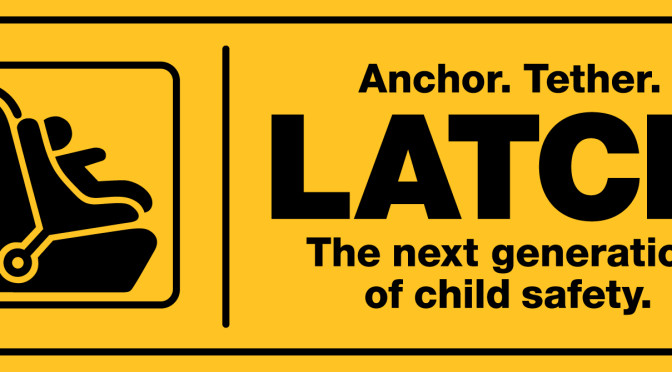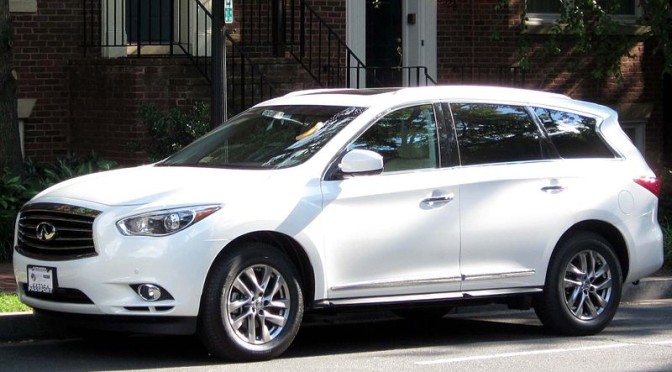The Mercedes-Benz GLC / GLK-Class, (e.g., the GLK 320 & GLK 350) is one of two mid-sized 5-passenger SUVs currently sold by Mercedes-Benz in the United States. It competes with its stablemate the M-Class, as well as with several other 5-passenger luxury crossovers, including the Volvo XC60, BMW X3, Acura RDX, Lexus RX, and Audi Q5 among families who don’t need a full time 3rd row but who are looking for safety, style, and high-end transportation.
When it comes to safety, the GLC (formerly known as the GLK-Class) is near the top of the heap in a very important category. In my comparison of SUVs with the best levels of side impact crash protection, I calculated that the GLK-Class was the second- best SUV you could be in during a side impact collision, which was impressive.
Given its safe, sturdy, and stylish design, I became curious about which car seats would fit well across the back seat of the GLK-Class, especially after having made 3 across guides for a number of other Mercedes’, including the GL-Class, M-Class, E-Class, and C-Class (which is designed to be the car counterpart of the GLK). What I found was pleasantly surprising; there was actually a good amount of interior room in the GLK-Class. So which seats worked and which seats didn’t? We’ll get to that in a second. First, let’s take a look at some best practice in car seat selection, orientation, and installation.
The safest configuration we know of when it comes to vehicle safety is rear-facing. I recommend rear-facing your children long past age 1, which is the legal requirement in most states, and going well into the preschool years (ideally until 4!), before forward-facing them in harnessed convertible or combination seats (ideally until 8!). Once they outgrow their harnessed seats, it’s best to keep them restrained in high-back boosters until they’re physically and psychologically ready to use adult seat belt systems (which typically happens between 10 and 12). We want our little ones in the safest positions we know of for as long as possible to give them the greatest advantages in a collision.
Keeping these ideas in mind, I set to work to find which infant, convertible, combination, and booster seats would work best in 3 across combinations in the GLC/ GLK-Class. It’s my goal to make this list the most thorough on the Internet. If you find the list helpful when shopping for car seats, you can shop through my Amazon link below. I’ll add more seats as I test them over time.
You can access the complete 3 across guide for every vehicle here and the complete list of recommended seats here. The Canadian car seat guide is here. 3 across car seat images are courtesy of Wikipedia.
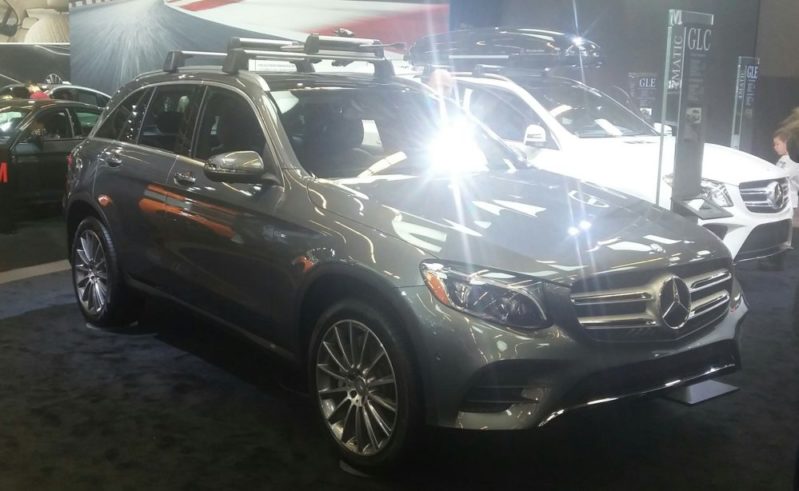 2016 Mercedes-Benz GLC-Class
2016 Mercedes-Benz GLC-Class
Guaranteed 3 across installations:
Clek Fllo (x3).
Clek Foonf (x3).
Diono Radian RXT (x3).
Diono Radian R120 (x3).
Diono Radian R100 (x3).
Combi Coccoro (x3).
Clek Fllo, Diono Radian / RXT, Diono Radian / RXT.
Clek Fllo, Graco Size4Me 65, Diono Radian / RXT.
Chicco KeyFit 30, Clek Fllo, Chicco KeyFit 30.
Tips and Tricks:
The current and only generation of the Mercedes-Benz GLC-Class is 183 inches long and slightly more than 74 inches wide. What this means is that you’ll have a significantly easier time in 3 across setups in the GLC than in the GLK-Class.
The biggest challenge you’re likely to face when using car seats (3, 2, or even just 1) in this SUV isn’t the left-to-right space but the front-to-back space. Like the GLK (although several inches better), the GLC is a rather short SUV, which translates into rear seats that are pretty close to the front seats, which means you’re going to struggle having enough space for a rear-facing recline while having room up front for the driver and passenger.
Regardless of whether you’re in the GLC or the GLK, you’ll definitely want to take advantage of the seat belt system instead of the LATCH anchors to make the most of your available space. And given the shorter length of the GLC, if you’re going with a Radian, which is what I’d recommend if you’re planning on rear-facing, you’ll definitely want to pick up the angle adjuster for each Radian you buy; they’ll give you several inches of front-row space back for both the driver and front-row passenger.
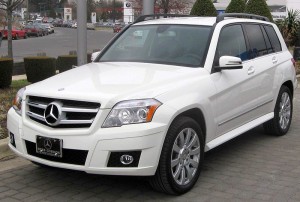 2010, 2011, 2012, 2013, 2014, 2015 Mercedes-Benz GLK-Class (X204)
2010, 2011, 2012, 2013, 2014, 2015 Mercedes-Benz GLK-Class (X204)
Guaranteed 3 across installations:
Clek Fllo (x3).
Clek Foonf (x3).
Diono Radian RXT (x3).
Diono Radian R120 (x3).
Diono Radian R100 (x3).
Combi Coccoro (x3).
Clek Fllo, Diono Radian / RXT, Diono Radian / RXT.
Clek Fllo, Graco Size4Me 65, Diono Radian / RXT.
Chicco KeyFit 30, Clek Fllo, Chicco KeyFit 30.
Tips and Tricks:
The only generation of the Mercedes-Benz GLK-Class is 178 inches long and between 72 and 74 inches wide, depending on whether you’re driving a 2009-2011 model or a 2012 and newer model. What this means is that your 3 across abilities will be significantly impacted by how new of a GLK you own, unfortunately. As a result, I put together a list designed to accommodate both the narrower and wider versions of the GLK.
The biggest challenge you’re likely to face when using car seats (3, 2, or even just 1) in this SUV isn’t the left-to-right space but the front-to-back space. The GLK is a rather short SUV, which translates into rear seats that are pretty close to the front seats, which means you’re going to struggle having enough space for a rear-facing recline while having room up front for the driver and passenger.
Regardless of which version of the GLK you’re driving, you’ll definitely want to take advantage of the seat belt system instead of the LATCH anchors to make the most of your available space. And given the shorter length of the GLK, if you’re going with a Radian, which is what I’d recommend if you’re planning on rear-facing, you’ll definitely want to pick up the angle adjuster for each Radian you buy; they’ll give you several inches of front-row space back for both the driver and front-row passenger.
—
If you find the information on car safety, recommended car seats, and car seat reviews on this car seat blog helpful, you can shop through this Amazon link for any purchases, car seat-related or not. Canadians can shop through this link for Canadian purchases.
3 Across Installations: Which Car Seats Fit a Chevrolet Suburban?
The “Chevy” Chevrolet Suburban is easily the most popular “extended length” SUV available in the United States. It competes with other extra-long SUVs like the Ford Expedition EL and its badge twin the GMC Yukon XL, as well as with shorter but still quite large SUVs like the Chevrolet Tahoe, Dodge Durango, GMC Yukon, Nissan Armada, Toyota Sequoia, Buick Enclave, Chevrolet Traverse, GMC Acadia, and Ford Expedition.
Of these vehicles, besides the Yukon XL, the Tahoe and regular Yukon are the closest twins of the Suburban; they’re basically the same vehicle but around 20 inches shorter. The extra length provides a usable storage space behind the 3rd row seats, but it doesn’t change any of the possibilities when it comes to 3 across installations. People interested in vehicles with 9-passenger seating don’t have many vehicles to choose from that aren’t either full-sized vans (e.g., the Nissan NV or Ford Transit 12-passenger vans) or small school buses, which is part of what makes the Suburban so desirable for some parents, social groups, or small businesses.
That said, I still wanted to make sure the Suburban was as car-seat friendly when it came to 3 across installations as the other SUVs with which it’s frequently cross-shopped. The good news is that ye, you can fit just about any combination of car seats you’re interested in inside a Suburban, with very few exceptions. Before going into some of the easier and more difficult installations, here are some general tips on when to use which kinds of car seats.
First of all, I suggest rear-facing from day one until you can’t anymore. Rear-facing is the way to go even if it takes you through the preschool years (ideally until 4!). Once you can’t fit your child in a rear-facing seat anymore, forward-face him or her in harnessed convertible or combination seats (ideally until 8!). Once your children outgrow their harnessed seats, it’s best to keep them restrained in high-back boosters until they’re physically and psychologically ready to use adult seat belt systems (which typically happens between 10 and 12). The overriding goal is safety, which comes from using certain kinds of seats at certain times.
With all that out of the way, here are some of the combinations of car seats you’re likely to get to fit well inside your Suburban, although the exact fits will naturally vary with your model year, the seats you’re using, and of course, the installation method.
The list isn’t complete, but it’s my goal to make it as complete as possible over time. If you find the list helpful when shopping for car seats, you can shop through my Amazon link below. I’ll add more seats as I test them over time.
You can access the complete 3 across guide for every vehicle here and the complete list of recommended seats here. The Canadian car seat guide is here. 3 across car seat images here are courtesy of Wikipedia.
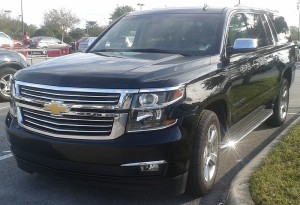 2015 Chevrolet Suburban (GMT K2YC/G)
2015 Chevrolet Suburban (GMT K2YC/G)
Guaranteed 3 across installations
(2nd or 3rd row unless noted):
Clek Fllo (x3).
Clek Foonf (x3).
Britax Boulevard ClickTight, Diono Radian / RXT, Britax Frontier G1.1.
Britax Boulevard G4.1, Diono Radian / RXT, Britax Frontier G1.1.
Britax Marathon ClickTight, Diono Radian / RXT, Britax Frontier G1.1.
Britax Marathon G4.1, Diono Radian / RXT, Britax Frontier G1.1.
Britax Boulevard ClickTight, Diono Radian / RXT, Britax Frontier G1.1.
Britax Pavilion G4, Diono Radian / RXT, Britax Frontier G1.1.
Diono Radian / RXT, Chicco KeyFit 30, Graco TurboBooster.
Diono Radian / RXT, Diono Radian / RXT, Graco TurboBooster.
Britax Boulevard ClickTight, Clek Fllo, Britax Frontier G1.1.
Britax Boulevard G4.1, Clek Fllo, Britax Frontier G1.1.
Britax Marathon ClickTight, Clek Fllo, Britax Frontier G1.1.
Britax Marathon G4.1, Clek Fllo, Britax Frontier G1.1.
Britax Boulevard ClickTight, Clek Fllo, Britax Frontier G1.1.
Britax Pavilion G4, Clek Fllo, Britax Frontier G1.1.
Tips and Tricks:
The current generation of the Chevrolet Suburban is 224 inches long and more than 80 inches wide, which means you’re going to have very little trouble fitting 3 car seats of any kind across the interior. That said, to have additional space, you’re still going to want to consider using your seat belts instead of the LATCH system, especially if you’re dealing with wider seats, such as 3 Rainiers or Britax Advocates.
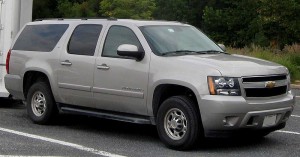 2007, 2008, 2009, 2010, 2011, 2012, 2013, 2014 Chevrolet Suburban (GMT900)
2007, 2008, 2009, 2010, 2011, 2012, 2013, 2014 Chevrolet Suburban (GMT900)
Guaranteed 3 across installations
(2nd or 3rd row unless noted):
Clek Fllo (x3).
Clek Foonf (x3).
Britax Boulevard ClickTight, Diono Radian / RXT, Britax Frontier G1.1.
Britax Boulevard G4.1, Diono Radian / RXT, Britax Frontier G1.1.
Britax Marathon ClickTight, Diono Radian / RXT, Britax Frontier G1.1.
Britax Marathon G4.1, Diono Radian / RXT, Britax Frontier G1.1.
Britax Boulevard ClickTight, Diono Radian / RXT, Britax Frontier G1.1.
Britax Pavilion G4, Diono Radian / RXT, Britax Frontier G1.1.
Diono Radian / RXT, Chicco KeyFit 30, Graco TurboBooster.
Diono Radian / RXT, Diono Radian / RXT, Graco TurboBooster.
Britax Boulevard ClickTight, Clek Fllo, Britax Frontier G1.1.
Britax Boulevard G4.1, Clek Fllo, Britax Frontier G1.1.
Britax Marathon ClickTight, Clek Fllo, Britax Frontier G1.1.
Britax Marathon G4.1, Clek Fllo, Britax Frontier G1.1.
Britax Boulevard ClickTight, Clek Fllo, Britax Frontier G1.1.
Britax Pavilion G4, Clek Fllo, Britax Frontier G1.1.
Tips and Tricks:
The 2007-2014 generation of the Chevrolet Suburban is 222 inches long and more than 79 inches wide, which again means you’re going to have very little trouble fitting 3 car seats of any kind across the interior. That said, to have additional space, you’re still going to want to consider using your seat belts instead of the LATCH system, especially if you’re dealing with wider seats, such as 3 Rainiers or Britax Advocates.
You can fit up to 6 car seats across the 2nd and 3rd rows of this generation of the Suburban if you buy the LS trim level. If you invest in the LT2 or LT3 models, you can choose between the ability to install 4, 5, or 6 car seats. You can technically fit car seats in the 1st row as well, but with all the room in the rear rows, I’d try to stay away from the 1st row if at all possible, due to the additional protection sitting in the back seats offers from frontal collisions, which are the most common.
Keep in mind that the 3rd row only includes one top tether anchor and lower anchors aren’t available. There are only two LATCH anchors in the 2nd row (on the center and right spots) with the 60/40 seat
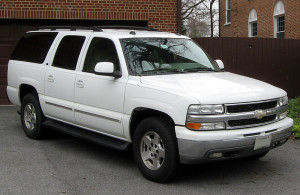 2000, 2001, 2002, 2003, 2004, 2005, 2006 Chevrolet Suburban (GMT800)
2000, 2001, 2002, 2003, 2004, 2005, 2006 Chevrolet Suburban (GMT800)
Guaranteed 3 across installations
(2nd or 3rd row unless noted):
Clek Fllo (x3).
Clek Foonf (x3).
Britax Boulevard ClickTight, Diono Radian / RXT, Britax Frontier G1.1.
Britax Boulevard G4.1, Diono Radian / RXT, Britax Frontier G1.1.
Britax Marathon ClickTight, Diono Radian / RXT, Britax Frontier G1.1.
Britax Marathon G4.1, Diono Radian / RXT, Britax Frontier G1.1.
Britax Boulevard ClickTight, Diono Radian / RXT, Britax Frontier G1.1.
Britax Pavilion G4, Diono Radian / RXT, Britax Frontier G1.1.
Diono Radian / RXT, Chicco KeyFit 30, Graco TurboBooster.
Diono Radian / RXT, Diono Radian / RXT, Graco TurboBooster.
Britax Boulevard ClickTight, Clek Fllo, Britax Frontier G1.1.
Britax Boulevard G4.1, Clek Fllo, Britax Frontier G1.1.
Britax Marathon ClickTight, Clek Fllo, Britax Frontier G1.1.
Britax Marathon G4.1, Clek Fllo, Britax Frontier G1.1.
Britax Boulevard ClickTight, Clek Fllo, Britax Frontier G1.1.
Britax Pavilion G4, Clek Fllo, Britax Frontier G1.1.
Tips and Tricks:
The 2000-2006 generation of the Chevrolet Suburban is 219 inches long and 79-80 inches wide, which again means you’re going to have very little trouble fitting 3 car seats of any kind across the interior. That said, to have additional space, you’re still going to want to consider using your seat belts instead of the LATCH system, especially if you’re dealing with wider seats, such as 3 Rainiers or Britax Advocates.
—
If you find the information on car safety, recommended car seats, and car seat reviews on this car seat blog helpful, you can shop through this Amazon link for any purchases, car seat-related or not. Canadians can shop through this link for Canadian purchases.
3 Across Installations: Which Car Seats Fit a Mercedes C-Class?
The Mercedes C-Class sedan is one of the safest cars you can buy these days in the United States when it comes to its ability to help you survive a side impact crash, and is also one of the safest cars on the market in terms of actual driver death rates. I’ve written about side impact ratings and ranked the best cars for surviving side collisions here, as well as the safest cars for families in terms of driver survival here, and the C-Class is one of the most side impact-resistant cars out there at the moment, as well as one of the cars drivers are least likely to die in, with a driver death rate of 7 and 10 in the 4WD and 2WD ’08-’11 models respectively. In other words, much like its bigger sibling the E-Class, it’s a safe car.
Partly due to its reputation for safety and partly due to its MB legacy , the C-Class sedan also competes well within the mid-sized luxury market (which includes vehicles like the Acura TLX, Infiniti Q50, Volvo S60, BMW 3 Series, and Audi A4) among families interested in safe and comfortable transportation for themselves and their little ones. Let’s take a look at how the C-Class sedan does in the most practical of quests: fitting 3 car seats across its back row of seats. Before doing so, however, a quick review of best practices in seating choices is always useful.
I always advocate beginning with rear-facing, and continuing to do so with young children for as long as possible (ideally until 4!). After rear-facing, next comes forward-facing in harnessed convertible or combination seats (ideally until 8!). Once kids are too big for forward-facing harnessed seats, booster seats are the next step until they pass the 5-step test for using adult vehicle seats and adult seat belts (which typically happens between 10 and 12). The longer you keep your kids safely restrained, the better their odds of crash survival.
With these ideas in mind, I borrowed a few C-Class sedans and tried out a variety of convertible, infant, and combination seats to see which 3 across car seat combinations were most likely to work for most parents. The list is small, but it’s accurate. If you find the list helpful when shopping for car seats, you can shop through my Amazon link below. I’ll add more seats as I test them over time.
You can access the complete 3 across guide for every vehicle here and the complete list of recommended seats here. The Canadian car seat guide is here. 3 across car seat images are courtesy of Wikipedia.
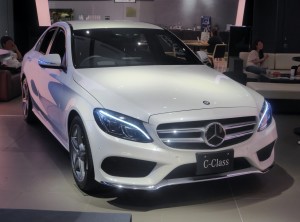 2015, 2016, 2017 Mercedes C-Class
2015, 2016, 2017 Mercedes C-Class
Guaranteed 3 across installations:
Clek Fllo (x3).
Clek Foonf (x3).
Chicco KeyFit 30 (x3).
Diono Radian RXT (x3).
Diono Radian R120 (x3).
Diono Radian R100 (x3).
Diono Radian / RXT, Diono Radian / RXT, Graco TurboBooster.
Diono Radian / RXT, Diono Radian / RXT, Graco Nautilus.
Britax Parkway SGL, Britax Boulevard G4.1, Diono Radian / RXT.
Graco Snugride 35, Britax Boulevard G4.1, Diono Radian / RXT.
Diono Radian / RXT, Britax Boulevard G4.1, Diono Radian / RXT.
Britax Parkway SGL, Britax Marathon G4.1, Diono Radian / RXT.
Graco Snugride 35, Britax Marathon G4.1, Diono Radian / RXT.
Diono Radian / RXT, Britax Marathon G4.1, Diono Radian / RXT.
Tips and Tricks:
The current generation of the Mercedes C-Class is 185 inches long and 71 inches wide, which places it on the narrower end of most mid-sized family cars. It’s narrower than a Camry or Accord, for instance. That said, it’s wider than a Civic, and there’s a lot of potential within it if you’re willing to take your time and use seat belt installations instead of the LATCH system, which I always recommend doing in 3 across setups.
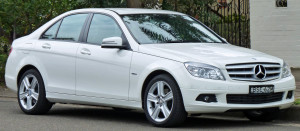 2009, 2010, 2011, 2012, 2013, 2014 Mercedes C-Class
2009, 2010, 2011, 2012, 2013, 2014 Mercedes C-Class
Guaranteed 3 across installations:
Clek Fllo (x3).
Clek Foonf (x3).
Chicco KeyFit 30 (x3).
Diono Radian RXT (x3).
Diono Radian R120 (x3).
Diono Radian R100 (x3).
Diono Radian / RXT, Diono Radian / RXT, Graco TurboBooster.
Diono Radian / RXT, Diono Radian / RXT, Graco Nautilus.
Britax Parkway SGL, Britax Boulevard G4.1, Diono Radian / RXT.
Graco Snugride 35, Britax Boulevard G4.1, Diono Radian / RXT.
Diono Radian / RXT, Britax Boulevard G4.1, Diono Radian / RXT.
Britax Parkway SGL, Britax Marathon G4.1, Diono Radian / RXT.
Graco Snugride 35, Britax Marathon G4.1, Diono Radian / RXT.
Diono Radian / RXT, Britax Marathon G4.1, Diono Radian / RXT.
Tips and Tricks:
The 2009-2014 generation of the Mercedes C-Class is 182 inches long and 70 inches wide, or 3 inches shorter and 1 inch narrower than the succeeding generation. It’s still a decent vehicle for 3 across setups, but you’ll have to work for it a bit more than you would with the newest C-Class. Again, take your time, use your seat belts for additional side-to-side room, and you’ll find a lot more combinations are possible than what you’d expect from a peek at the back seat.
—
If you find the information on car safety, recommended car seats, and car seat reviews on this car seat blog helpful, you can shop through this Amazon link for any purchases, car seat-related or not. Canadians can shop through this link for Canadian purchases.
When to use seat belts vs. LATCH for car seats, and which is safer?
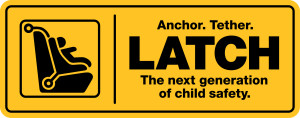 One of the most frequently-asked questions I receive related to car seat installations comes from parents wondering whether to use the LATCH system or the seat belts that come with their vehicles. Unfortunately, there’s a lot of confusion about these two systems and a lot of misconceptions about the safety of one vs. the other. Today we’ll take a look at some of the more common questions I’ve received regarding these systems to help you make the safest decisions for your children.
One of the most frequently-asked questions I receive related to car seat installations comes from parents wondering whether to use the LATCH system or the seat belts that come with their vehicles. Unfortunately, there’s a lot of confusion about these two systems and a lot of misconceptions about the safety of one vs. the other. Today we’ll take a look at some of the more common questions I’ve received regarding these systems to help you make the safest decisions for your children.
Which is safer for installing car seats: seat belts or LATCH?
The truth is that neither is more safe than the other when used properly. According to government testing standards, there aren’t any safety-related advantages to using seat belts over LATCH lower anchors, or LATCH lower anchors over seat belts, provided that the seats are installed correctly.
The LATCH system is simply designed to be an easier method for parents to use when installing car seats. It was designed to make the process more fool-proof, particularly in light of how most car seats aren’t installed correctly, with one of the most common errors being that the seats aren’t installed tightly enough. Per the NHTSA, 3 of every 4 seats are installed incorrectly, and LATCH is simply one of many efforts to reduce the rate of incorrectly installed seats. If you or someone helps you achieve a correct install, both systems are equally safe. Conversely, an incorrect installation through either method is unsafe.
However, if a properly-used LATCH system is as safe as a seat belt when it comes to installing a car seat, that begs another question…
Why use seat belts when I can use LATCH? Isn’t LATCH easier?
Many parents wonder why they’d bother with seat belts at all if they have LATCH lower anchors available on their vehicles, which is typically the case for almost all vehicles manufactured after 2001. LATCH, after all, is usually easier to use with car seats than the seat belt. I personally find it faster and also enjoy how it requires less effort to get a solid install (remember, 1″ or less movement at the base of the seat). So why should parents even consider using seat belts with their kids’ car seats?
The big reason is that you can use seat belts all the time, with virtually no exceptions. LATCH systems, however, always have weight limits, and the LATCH system is not rated as safe if those limits are exceeded. The limits vary from one car seat to the next and from one vehicle to the next, and you have to obey both the limits on the car seat and the limits on the vehicle for a LATCH installation to “count” as safe.
These weight limits may state, for example, that the LATCH system cannot be used once a child weighs more than 40 pounds, or once the child and car seat weigh more than a certain amount. It varies, and you need to be in compliance with both the seat and the vehicle’s limits. In contrast, when you’ve got a seat belt, you simply install your seat with it and that’s it. There’s no need to look up anything related to weight, as seat belts are designed to hold adults–in many cases, very heavy adults–safely.
2014 Update: As of February 27th, 2014, seats made from this date onward (check the label on the seat) in the US will typically have a 65 pound combined LATCH weight limit (i.e., that of the child and the seat together) for rear-facing and a 69 pound combined LATCH weight limit for forward-facing. This means you shouldn’t need to check vehicle weight limits anymore. However, you still need to check the label on the seat or in the manual, as a few manufacturers are more conservative and won’t allow you to go up to 65 / 69 pounds combined.
So we’ve established that under the right conditions there’s no safety difference between seat belts and LATCH, but that you don’t need to worry about weight limits when using seat belts. However, there’s another big, big reason to consider using seat belts over LATCH lower anchors when you can choose between the two of them…
Should I use seat belts or LATCH when installing multiple car seats? (e.g., 3 across)
Whenever I write one of the hundreds of 3 across car seat guides I’ve put together, I almost always advocate for using seat belts for 3 across installations instead of LATCH whenever possible. But why? After all, if seat belts and LATCH systems offer the same amount of safety when used correctly, does it matter which you use when installing multiple car seats?
Well, no and yes. It doesn’t matter if you’ve got a lot of room for your installations, but it does matter if you don’t. And unless you’re driving a full-size pickup truck (and even then, it’s not necessarily a given), there’s a good chance that you’re not going to have nearly as much flexibility in a given amount of space to install 3 car seats if you use LATCH instead of if you use seat belts. But why?
The trick is in the spacing. With few exceptions, LATCH anchors tend to be located more toward the center of the seats in which they’re installed. On top of that, most vehicles only include two sets of LATCH lower anchors, which are typically built into the outboard seats. This means you’re going to need to use the seat belt in the center seat for a 3 across installation regardless of whether you prioritize LATCH or not. And if you do use LATCH, your outboard seats are going to be installed more toward the center, leaving less room for your center seat, reducing the odds of a successful 3 across installation, and requiring you to use narrower seats in each position. And this presumes the LATCH anchors are evenly spaced, which also isn’t always the case.
In contrast, when you use seat belts, you have more flexibility with where you place a car seat relative to the vehicle seat. This means you can push the outboard seats closer to the doors before installing them, which allows you to install wider seats in a given vehicle or the same-sized seats in a narrower vehicle. In other words, you get more options.
So in review, not only are seat belts as safe as the LATCH system, they also don’t have weight limits and make it easier to install multiple car seats at a time. It sounds like there just aren’t that many advantages to LATCH! This leads to another question…
If seat belts can be used all the time and LATCH can’t, why use LATCH at all?
The main reason to use LATCH, in my opinion, is because it’s both faster than a seat belt installation and takes less effort, even when you’re accomplished at both. It’s faster because you can typically do it one-handed, and you don’t need to figure out whether your seat belt locks or how to lock it or where to thread it through your car seat. You simply clip in your lower tether to the anchor and pull it taut on one side of the seat, and then do the same with the corresponding tether and anchor on the other side. That’s it.
It takes less effort because you don’t need to weigh down the car seat to make sure there’s enough tension in the seat belt. This often entails pushing down with one or both arms into the seat or even sitting inside it briefly when you’re using a seat belt, which is, frankly, a lot of work. You don’t need to do this with LATCH anchors, so LATCH is an easier system for people who can’t or don’t want to put a lot of force into the installation.
With both systems, naturally, you still need to make sure that there’s less than an inch of movement at the installation path, whether that installation is done with a seat belt or with LATCH anchors.
At this point, we’ve covered situations where using LATCH or seat belts are fully up to parents. However, there are a few situations involving tethering that do require LATCH systems if you choose to use them: forward- and rear-facing tethering.
What about forward-facing tethering? Do I need to do this?
Forward-facing tethering involves using the upper LATCH anchor system to tether the back of a forward-facing seat to an anchor somewhere behind the vehicle seat. There’s no option for a seat belt here; you have to use the LATCH system. Fortunately, it’s a simple procedure and there are a number of advantages to forward-facing tethering. In fact, while it’s not yet the law in the United States, it’s required in Canada. You can learn more about forward-facing tethering and why it’s a good idea here.
Besides forward-facing, it’s actually possible to tether car seats while they’re rear-facing. Let’s look at that briefly…
What about rear-facing tethering? Does anyone do this?
As with forward-facing tethering, your only options here are the LATCH system. However, unlike with forward-facing tethering, in the United States, rear-facing tethering is so rare that almost no one does it, even though rear-facing tethering does offer several advantages. You can read more about those here and decide if you’re willing to purchase car seats that make it possible.
Finally, parents occasionally ask about booster seats on the market (e.g., the Clek Oobr) that include LATCH restraints, so let’s take a quick look at why you might want to consider seats that include this feature.
What about using LATCH with booster seats? Is this even possible?
Booster seats are the last step in car seats before the adult seat belt and vehicle seat. I’ve written before about the 5-step test for exiting booster seats, and you’ll see seat belts referenced over and over again in such guides. So why would LATCH be mentioned here?
The reason LATCH can sometimes come into play with booster seats is because many parents forget that booster seats aren’t restrained to the vehicle’s seats except for when they’re buckled. Naturally, your child uses the seat belt to buckle himself or herself in while sitting in the seat, but kids often forget to buckle in the seats when they aren’t using them. And a 10-to 20-pound booster seat can easily become a fatal flying projectile in a collision if it’s not restrained. LATCH systems allow you to have seats permanently anchored to the vehicle, regardless of whether they’re being used or not. They don’t directly make your child safer, but they do make everyone in the vehicle safer if they reduce your odds of being hit by a flying booster seat in a collision.
I hope this has cleared up a number of questions you might have had regarding using LATCH vs. using seat belts, when to choose one system over the other, and certain advantages and disadvantages to keep in mind. You can learn about some of my favorite car seats (convertibles, infant seats, combination seats, and booster seats) here, as well as which ones are likely to fit into a vehicle you drive through my 3 across car seat guides here.
—
If you find the information on car safety, recommended car seats, and car seat reviews on this car seat blog helpful, you can shop through this Amazon link for any purchases, car seat-related or not. Canadians can shop through this link for Canadian purchases.
3 Across Installations: Which Car Seats Fit an Infiniti QX60 / JX35?
The Infiniti QX60 (formerly known as the JX35) is Infiniti’s mid-sized luxury crossover SUV, and Infiniti’s counterpart to the Nissan Pathfinder, on which it is based. The QX60 competes with an ever-growing number of 3-row mid-to-large sized luxury crossovers, including the Volvo XC90, Acura MDX, BMW X5, Mercedes-Benz GL-Class, Buick Enclave, Land Rover Range Rover Sport, Cadillac Escalade, Audi Q7, and of course the Nissan Pathfinder, despite that not being a luxury SUV.
Because it shares a platform (and close external and internal design features) with the Pathfinder, I expected there to be little, if any difference, between the two vehicles when it came to their abilities to fit 3 car seats across the 2nd row and an extra 2 as needed in the 3rd row, and that turned out to be the case. The Pathfinder and QX60 are about as different as the Traverse and the Enclave, which does make things easier for parents looking for information on car seat compatibility. At any rate, I decided it was still worth making a 3 across guide for the QX60 / JX35, so here we are. Before getting into the details, here’s a quick primer on why using different types of car seats at different stages of your child’s development is essential.
First of all, car seat safety starts with rear-facing from the day your child leaves the hospital, and for many years to come, due to the safety advantages it provides over forward-facing. Rear-facing is the way to go even if it takes you through the preschool years (ideally until 4!). Once you can’t fit your child in a rear-facing seat anymore, forward-face him or her in harnessed convertible or combination seats (ideally until at least 5 or 6!). Once your children outgrow their harnessed seats, it’s best to keep them restrained in high-back boosters until they’re physically and psychologically ready to use adult seat belt systems (which typically happens between 10 and 12). The overriding goal is safety, which comes from using certain kinds of seats at certain times.
My results of car seat puzzling and juggling in the Nissan Pathfinder are below. It’s not a complete list, but as with all of my 3 across guides, it’s my goal to make it the most complete on the Internet over time, especially as I get access to more seats. If you find the list helpful when shopping for car seats, you can shop through my Amazon link below. I’ll add more seats as I test them over time.
You can access the complete 3 across guide for every vehicle here and the complete list of recommended seats here. The Canadian car seat guide is here. 3 across car seat images are courtesy of Wikipedia.
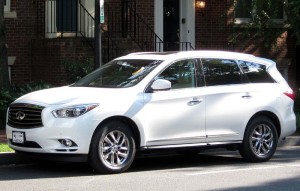 2013, 2014, 2015, 2016, 2017, 2018 Infiniti QX60 / JX35
2013, 2014, 2015, 2016, 2017, 2018 Infiniti QX60 / JX35
Guaranteed 3 across installations:
Clek Fllo (x3).
Clek Foonf (x3).
Peg Perego Flex 120 (x3).
Maxi-Cosi RodiFix (x3).
Diono Radian RXT (x3).
Diono Radian R120 (x3).
Diono Radian R100 (x3).
Chicco KeyFit 30 (x3).
Clek Oobr (x3).
Combi Coccoro (x3).
Graco Size4Me 65 (x3).
Graco Contender (x3).
Clek Fllo, Graco Size4Me 65, Diono Radian / RXT.
Clek Fllo, Graco Size4Me 65 (x2).
Clek Fllo, Diono Radian / RXT (x2).
Graco TurboBooster, Clek Fllo, Diono Radian / RXT.
Graco TurboBooster, Diono Radian / RXT (x2).
Tips and Tricks:
The current generation of the Infiniti QX60 / JX35 is 197 inches long and 77 inches wide (exactly the same as the Pathfinder). As a result, your 3 across odds are going to be strong with nearly any combination of seats you can put together. However, to make this work, you’ll need to use your seat belts. Why? The LATCH anchors in the QX60 (both in the outboard 2nd row positions) are relatively close together, so if you try to use them with 3 seats, there will probably be many seats you can’t get to work, despite the width of the SUV. Use the seat belts to maximize your space.
A downside to the current generation QX60 is that there aren’t any lower LATCH anchors in the third row. You can get around this easily by using the seat belt there, but you can’t get around the downside of only having a single tether anchor in the 3rd row. It’s located behind the passenger outboard seat, and you can easily confuse it with a number of cargo hooks behind the 3rd row. Tethering while forward-facing is important for safety, so if you need to forward-face multiple children, keep them in the 2nd row, as there are 3 tether anchors available for the three 2nd row seats.
—
If you find the information on car safety, recommended car seats, and car seat reviews on this car seat blog helpful, you can shop through this Amazon link for any purchases, car seat-related or not. Canadians can shop through this link for Canadian purchases.

